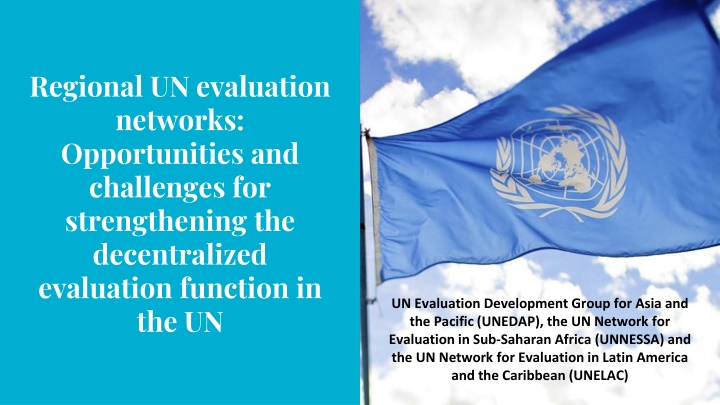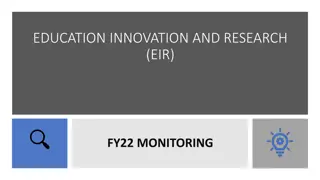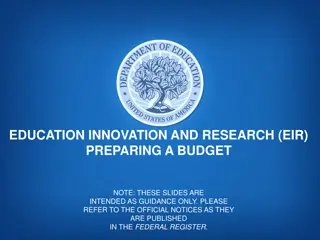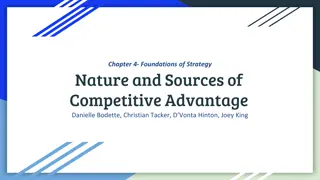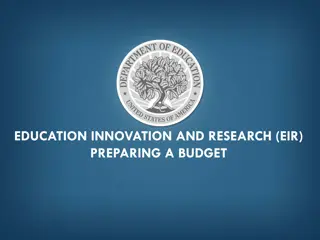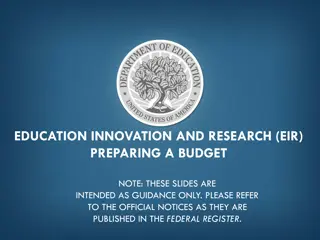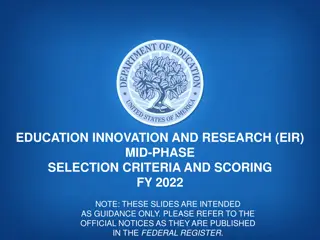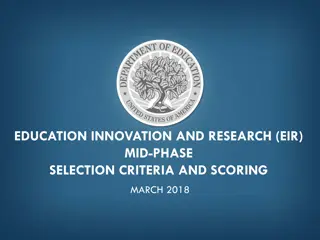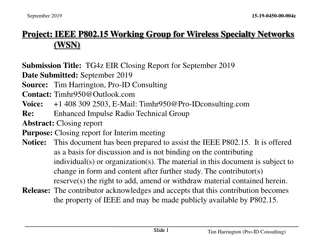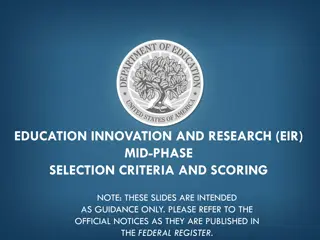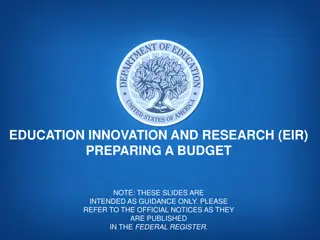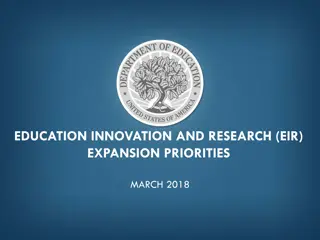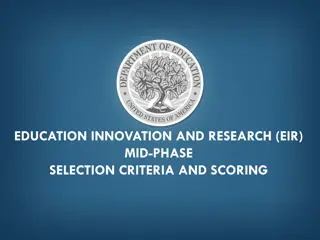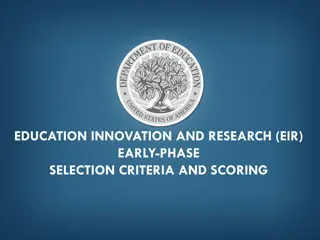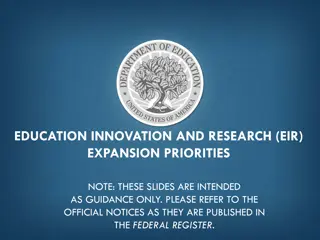EIR Mid-Phase Selection Criteria & Competitive Priorities
This guidance outlines the selection criteria and scoring for the Education Innovation and Research (EIR) mid-phase in FY 2022, covering aspects such as significance, scaling strategy, and project design quality.
Download Presentation

Please find below an Image/Link to download the presentation.
The content on the website is provided AS IS for your information and personal use only. It may not be sold, licensed, or shared on other websites without obtaining consent from the author.If you encounter any issues during the download, it is possible that the publisher has removed the file from their server.
You are allowed to download the files provided on this website for personal or commercial use, subject to the condition that they are used lawfully. All files are the property of their respective owners.
The content on the website is provided AS IS for your information and personal use only. It may not be sold, licensed, or shared on other websites without obtaining consent from the author.
E N D
Presentation Transcript
Regional UN evaluation networks: Opportunities and challenges for strengthening the decentralized evaluation function in the UN UN Evaluation Development Group for Asia and the Pacific (UNEDAP), the UN Network for Evaluation in Sub-Saharan Africa (UNNESSA) and the UN Network for Evaluation in Latin America and the Caribbean (UNELAC)
Timeline UNNESA created on: March 2020 UNELAC created on: 2010 as UN M&E WG/ June 2022 as UNELAC UNEDAP created on: February 2007
UNNESSA Mission Strengthen the evaluation function in the UN system in the Eastern and Southern Africa region Add value to evaluation work of the UNNEESA member agencies and the countries they serve. Membership 14 agencies across Sub-Saharan Africa Working areas/key initiatives Evaluation capacity development Technical support on evaluations Knowledge exchange around evaluations
UNEDAP Mission Aims to promote an evaluation culture and coherence of evaluation practices in the UN system Membership Consists of evaluation experts of 11 regional offices (ILO, IOM, UNICEF, UNDP, UN ESCAP, UNESCO, UN Women, UNFPA, UNOPS, WFP, FAO) and UNDCO-AP Included in the structure of the Regional Collaborative Platform in 2021 Working areas/key initiatives Organizes in-person or online evaluation trainings for all UN Agencies in the Asia-Pacific countries every year Provides technical advice to strengthen evaluations carried out by UN agencies in the Asia and the Pacific region, particularly UNSDCF and joint evaluations Advocates for influential evaluations to senior managers in the region
UNELAC 1. Mission Strengthen evaluation function across UN system in LAC Promote coordination, collaboration and foster synergies among UN entities around evaluations 1. Membership: 15 officers from 9 agencies with Regional Offices in LAC 2. Working areas/key initiatives i) Evaluation Capacity development ii) Technical support & QA to evaluations iii) Country -led SDG evaluations & NECD iv) joint evaluations & knowledge products
PANEL SESSION Challenges to establish & sustain an active Network Capacity Development DCO and Quality Assurance 1 2 3 UNEDAP UNNESSA UNELAC Speakers: Speakers: Speakers: - - Angeline Wambada, IOM Oyuna Chuluundorj, UNFPA - Kay Lau, UN Women - - Natalia Acosta, WFP Michael F. Craft, UN Women - - -
Capacity Development UNEDAP in-person or online evaluation training for all UN Agencies in the Asia-Pacific countries: It has been offered since 2009 with an objective of enhancing the quality and effectiveness of UN evaluations in the region; Each course trains approximately 35 staff from various UN agencies working in the region on evaluation management, including RCOs. Includes half-day workshops or online sessions on UNSDCF evaluations in collaboration with the Development Coordination Office (DCO); Colleagues from countries who recently conducted UNSDCF evaluations are invited to present and discuss challenges and good practices.
Structure of the UNEDAP evaluation course Preparing for an evaluation Supporting the evaluation team Helping stakeholders use the evaluation 1 2 3 Step 1: Identify users and use Step 1: What data sources are available? Step 1: Share findings and recommendations Step 2: Make sure it can be evaluated Step 2: Provide quality control for the inception phase Step 3: Define purpose and scope of the evaluation Excursion: Data visualization for evaluations Step 4: What questions should it answer? Step 3: Provide support and supervision to evaluation team Step 2: Coordinate the management response Step 5: Define approach and methodologies Step 6: Put it all together in Terms of Reference Step 4: Support and ensure the quality of the evaluation report Step 3: Using evaluation for managing results Excursion: Ethics in evaluations
DCO and Quality Assurance Using standard UNSDCF template and providing 2022 activity collated feedback consistent with UNSDCF Quality assuring guidance UNDAF / UNSDCF Clarifying ways of working with the DCO, RCO evaluation TORs, and country teams inception and final Opportunity to increase support across planning reports and managing evaluations Opportunity to strengthen forward planning to ensure sufficient lead time
Support to UNSDCF evaluations in partnership with DCO
Challenges to establish & sustain a Network > Formalizing the group under the auspices of the Regional Collaborative Vice Chairs > Time availability of members to sustain an active and continuous engagement SUCCESS FACTORS: having engaged co-chairs leading the network and working group leads Focus on concise/ concrete activities where many can contribute > Kicking off the work in some of the working groups (i.e. joint assessments and evaluations)
